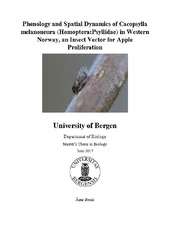| dc.contributor.author | Brede, Åsne Vik | |
| dc.date.accessioned | 2017-06-21T08:29:27Z | |
| dc.date.available | 2017-06-21T08:29:27Z | |
| dc.date.issued | 2017-06-21 | |
| dc.date.submitted | 2017-06-20T22:00:03Z | |
| dc.identifier.uri | https://hdl.handle.net/1956/16036 | |
| dc.description.abstract | In the last decade, the plant disease apple proliferation has caused problems for Norwegian fruit farmers, resulting in smaller and un-tasty apples, rendering them unsellable. The disease is caused by the phytoplasma Candidatus phytoplasma mali, a bacteria residing in the phloem of the plant. Apple proliferation is spread by infected propagation material, vascular connections and insect vectors. There is no cure for the disease, and to limit further spread, infected trees have been removed. Nonetheless, apple proliferation remains a severe problem. In Norway, the phytoplasma is believed to be spread by an insect vector; Cacopsylla melanoneura, as the main European vector Cacopsylla picta is not found in Norway. The aim of this study was to map the phenology of C. melanoneura, and to find if their occurrence in apple orchards can be predicted based on infected and healthy apple trees. This was done by monitoring populations of C. melanoneura in four apple orchards in western Norway by using yellow sticky traps and the beat-tray method, from March to June. The results show that C. melanoneura leaves their overwintering habitat early in the spring before bud break, when the temperature reach somewhere between 7 and 8.4°C. There was a population peak in midApril, and the old generation of psyllids was gone by the first weeks of June. The main reproductive period seemed to occur in the April-May transition, and nymphs appeared from the end of May, when the apple trees were flowering. There was no indication of attraction towards infected or healthy trees in the overwintered generation of C. melanoneura in this study, but there was a significant result of larger trees hosting more psyllids than smaller trees in the same field, and thus may be a source of large quantities of infected nymphs if the larger trees are infected. | en_US |
| dc.language.iso | eng | eng |
| dc.publisher | The University of Bergen | en_US |
| dc.subject | Frukttrær | nob |
| dc.subject | Epler | nob |
| dc.subject | Plantepatologi | nob |
| dc.subject | Bakterielle sykdommer | nob |
| dc.subject | Homoptera | nob |
| dc.subject | Norge | nob |
| dc.title | Phenology and Spatial Dynamics of Cacopsylla melanoneura (Homoptera:Psyllidae) in Western Norway, an Insect Vector for Apple Proliferation | en_US |
| dc.type | Master thesis | |
| dc.date.updated | 2017-06-20T22:00:03Z | |
| dc.rights.holder | Copyright the Author. All rights reserved | en_US |
| dc.description.degree | Masteroppgave i biologi | en_US |
| dc.description.localcode | BIO399 | |
| dc.subject.realfagstermer | https://data.ub.uio.no/realfagstermer/c009836 | |
| dc.subject.realfagstermer | https://data.ub.uio.no/realfagstermer/c010549 | |
| dc.subject.realfagstermer | https://data.ub.uio.no/realfagstermer/c030753 | |
| dc.subject.realfagstermer | https://data.ub.uio.no/realfagstermer/c002623 | |
| dc.subject.realfagstermer | https://data.ub.uio.no/realfagstermer/c008264 | |
| dc.subject.realfagstermer | https://data.ub.uio.no/realfagstermer/c004661 | |
| dc.subject.nus | 751999 | eng |
| fs.subjectcode | BIO399 | |
| fs.unitcode | 12-60-00 | |
